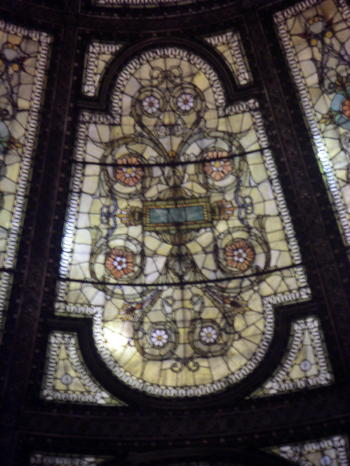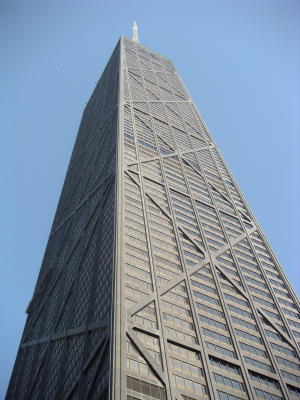|
|
 |
|

|
| GAR Hall, Chicago Cultural Center. GTJ Photo. |
|
 |
If you only have time to visit...
- one downtown building, visit the Cultural Center at 78 East Washington. The grand beaux-arts building
was dedicated in 1897 as the first permanent home of the Chicago Public Library. It has two stained-glass domes and marbles
inlaid with mosaics, as well as coffered ceilings. And when you go, visit the G.A.R. Rotunda
and Hall. The 38-foot dome in Preston Bradley Hall is thought to be the world's largest Tiffany dome. The Sidney
Yates Gallery is based on features of the Palazzo Vecchio in Venice. As long as you are in the neighborhood,
visit Millenium Park across the street, which is Chicago's newest destination. Here are some of my own personal
memories of the Cultural Center, from the time it was a library: Personal Memories.
- one North Side Museum, visit the Chicago History Museum. Now that the Chicago galleries of the CHM have been renovated, this will be the ideal place to orient yourself
to a visit to Chicago. The motto, after all, is "Chicago Begins Here!" (OK, fair, enough. I am the
Director, but I'm not the only one who gives this advice.) As long as you are in the neighborhood,
begin a walk up near-by Lincoln Avenue for a sense of the Lincoln Park neighborhood. Walk at least as far as
the Biograph Theater at 2433-43 N. Lincoln Ave. This was the scene of the famous shooting of John Dillinger in 1934, after having
been named "Public Enemy No. 1" by the FBI. Walk back to Fullerton and then south through Lincoln Park, passing
the Lincoln Park Zoo, until you return to the Chicago Historical Society. View the Lincoln Park monument at north Dearborn Parkway and Lincoln Park, a fine work by Augustus Saint-Gaudens in an architectural setting by Stanford
White.
- one downtown museum, that's very hard, because downtown includes both the Art Institute of Chicago and
the Museum Campus, with the Field Museum, the Adler Planetarium and the Shedd Aquarium. The Museum Campus is worth
a whole day, and you should do it! Closest at hand for a quicker visit is the Impressionist collection at the
Art Institute of Chicago. And when you go, consider not only the beauty of the art, but also what it says about Chicago history. What
does it say about industrialization in Chicago that wealthy families, such as the Fields and the Palmers, were able
to make buying trips to Paris? What does it say about their taste in art, that these collectors were able to overlook
the art based on classical themes that was winning the academic prizes in Paris, and chose the bold, innovative work
of the Impressionists? What does it say about philanthropy in the United States that so many of these works wound up
in the hands of a museum in the space of only one or two generations? What does it say about civic pride in Chicago
at the end of the nineteenth century that the Art Institute, the Chicago History Museum and so many other museums, sprang
up in new buildings soon after the Chicago fire of 1871? In 1910, when the Art Institute held an exhibition of paintings
from the collection of Mrs. Potter Palmer, a Swedish-born member of my family, Alma Johnson, worked as a maid in the Palmer
residence. Did this accumulation of modern art that is now our city's pride and joy make an impression at the time
on those who served the city's civic leaders, either as servants or industrial workers? This art certainly
has had a major influence on their descendants, and I, for one, am very grateful for the education in art and
history that is part of my inheritance as a Chicagoan. Just across the street is the Pritzker Military Library. Take a moment there to honor the military, but whether there is time for that or not, you should check out the library's
award-winning web resources.
- one neighborhood museum, visit the DuSable Museum, which is named for Jean Baptist Pointe DuSable, a Haitian fur trader who was the first permanent settler in Chicago. And
when you go, consider the history of the African-American experience in Chicago. As long as you are
in the neighborhood, drive around Jackson Park, which was the site of the Columbian Exposition of 1893. This was the scene of the popular fictional account,
The Devil in the White City by Erik Larson. Frederick Law Olmsted (who designed New York's Central Park)
and Chicago's famous architect and planner Daniel H. Burnham laid out the fairgrounds. The park's "Golden Lady" sculpture
is a smaller version of Daniel Chester French's Statue of the Republic which originally stood at the foot of the Columbian
Exposition's Court of Honor and is very evocative of that period.
- one sports venue, visit Wrigley Field. And when you go, take the CTA Red Line north to Addison. Linger on the L platform
for a good view of the rooftop facilities, where fans watch the Cubs from the tops of neighboring buildings by looking over
the Sheffield Ave. and Waveland Ave. walls of the parks. Then walk around the park. You will find plenty to see,
whether there is a game scheduled or not. As long as you are in the neighborhood, walk to the 3800
north block of Alta Vista Terrace (1050 west), the "Street of Forty Doors," built 1900-1905. Then continue on to Graceland Cemetery, at Clark and Irving
Park Road. Get a self-guiding brochure in the cemetery office. Don't miss the Getty Tomb, designed by Louis Sullivan, as well as the tombs of civic leaders and architects associated with Chicago. You can
return by catching the Red Line at the Sheridan stop.
- one neighborhood away from the lakefront, visit Lincoln Square. This originally was a German neighborhood, north of the city boundary. It now is a popular
neighborhood for young professionals, but German elements remain. Greek, Asian and Latino communites also are present.
And when you go, don't miss the last work by architect Louis Sullivan, Krause Music Store (now an antique shop). As long as you are in the neighborhood, walk west a few blocks on Wilson Avenue.
The view north from the bridge over the Chicago River of homes with boatdocks is one of the most unexpected in town.
Explore the blocks on either side of the river, part of Ravenswood Manor and Ravenswood Gardens, which date from 1913..
- one high rise, visit the Hancock Observatory at 875 N. Michigan Ave. Most
Chicagoans agree that you can see more from the 94th-floor of the Hancock Building than from Sears Tower, which
is taller. And when you go, don't just look at the beauty of the lakefront and near-by skyscrapers.
Follow the lake as it bends south in Indiana, where some steel mills from the industrial era of the last century still remain
and where ships carry iron ore from the upper Great Lakes. Take a look at the Chicago River, beginning with its mouth
in Lake Michigan and then branching north and south, just west of the Loop. You probably have heard of the engineering
miracle of the late 19th century that reversed the flow of the river, so that it now flows in the direction of the Mississippi
River, thus preventing the cholera deaths that used to afflict this swampy city. Chicago grew up where it did because there
is a portage of only a few miles between the Chicago River and the Des Plaines River. Believe it or not, in
the flatness of the land between the sluggish Chicago and the Des Plaines Rivers, and between the Calumet and the Kankakee
Rivers, there is a continental divide between the Great Lakes basis and the Mississippi River basin. That's
why French explorers were interested in the site and the United States built Fort Dearborn in 1803. Now take
a look at the network of railroad lines and highways converging on Chicago, as well as the airplanes landing at O'Hare to
the northwest. Chicago began as a transportation hub, and it remains one.

|
| John Hancock Building |
|
 |
|
|
 |
|
|
 |
|
|
|
|
|
|
 |

